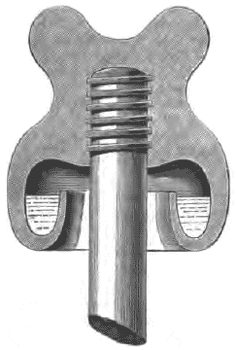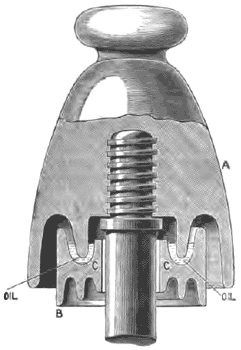[Trade Journal]
Publication: Electrical Review - London
London, England
vol. 33, no. 315, p. 6, col. 2
·
·
Experience has shown that the best insulators for high- voltage bare cables, carried on poles, are those in which surface leakage is prevented by a bath of highly insulating oil. There are various forms of these. One of the most common is shown in fig. 15, and consists of a single-bell porcelain insulator, with the bell formed into an annular channel to hold the oil. This form is open to the objection that insects may weave their webs across the top of the oil channel, thereby reducing the insulation resistance to a very small figure when the webs are damp with rain or dew. The insulator used on the Tivoli-Rome high-pressure line is superior in this respect, since the oil is quite enclosed. A diagram of this insulator is given in fig. 16, in which A is an ordinary double-bell porcelain insulator, and B is an adjustable insulator of the same material capable of carrying oil in an annular cavity, 0. When the lower insulator is pushed up into its proper place, the inner bell of the upper insulator dips into the oil, as shown, and effectually prevents accumulations of foreign matter from short circuiting it. The oil must be heavy and non-volatile ; resinous oils have been found to be the most serviceable. On this particular line, between Tivoli and Rome, there are four stranded copper cables, each 100 square millimetres in section and capable of carrying 120 amperes. The length of the line is 25 kilometres, and poles are arranged 35 metres apart. Each pole is 30 feet high, and is constructed of wrought-iron. There is a loss of 1,000 volts in transmission, the drop being from 5,000 volts at Tivoli to 4,000 at Rome.
 |
| Fig. 15. |
 |
| Fig. 16. |
·
·
